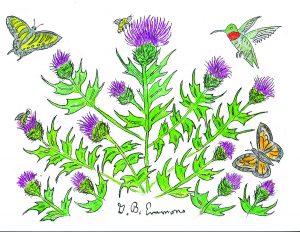A bull thistle has been growing by leaps and bounds all summer in our flower garden, and now stands five feet tall and looks into our bedroom window. Although classified as a member of the Astor family, we had only considered the bull thistle as an uninvited perennial weed until recently as it came into its surprisingly beautiful purple bloom. Now we look out at a mural of a floral painting framed by the windowsill in the morning light of another new day on Buzzards Bay.
The bull variety is New England’s prickliest thistle that can be a thorn in the side of the green thumb of a careless pruning gardener. Each spine of the leaf is pinnately lobed with a painful barb – similar to, but easier to extracted than, the quill of a porcupine. Still, there are avid horticulturists who intentionally plant them to emulate a meadow-type garden of woodland wildflowers.
In spring, a mixed packet of seeds that includes thistle seeds can be found in complete garden centers. And most bird food stores carry thistle seed with special feeders that cater to small finches, nuthatches, and chickadees. However, purchasing thistle seed may be unnecessary, because now, after fertilization of the blossoms by bees, butterflies, and hummingbirds, as in my illustration, the plant itself widely sews seeds in many directions. With a change in the prevailing wind, each day allows new plants to spring up the following year unexpectedly, sometimes in unwanted locations. Removal can be inconveniently painful.
The annual arrival of blossoms visually justifies garden location. Somehow there is an almost mystical transition of human appreciation, as if mother nature’s obstinate thistle brat has morphed into a fairy tale floral Cinderella. As the seasonal hands of the clock turn to the arrival of mid-summer, this ugly duckling transforms into the reproductive belle of the annual cotillion ball.
Equally as mythological in its history was the founding of the Order of the Thistle in Scotland by James VII of Scotland (James II of England and Ireland) in 1687. He intended to reward Scottish peers who supported both king and country. Today it is the next highest order of chivalry in England, second only to the Order of the Garter.
For each new ceremony of membership, knights and ladies ceremoniously dress in striking velvet robes, bright insignia, and plumed hats, and march into the Thistle chapel of St. Giles Cathedral. New members are installed into the order by the queen as a floral badge of honor.
England itself has its own flower – the rose; Wales – the daffodil; Ireland – the shamrock; Holland – the tulip; and Scotland – the thistle, whose emblem is second only to tartan. America unofficially also has adopted the rose. But I would also express the Native American qualification that every living thing on Earth, in its own way, is sacred. So I would look upon the thistle as a member of an elite order because it now lights up our lives with majestic purple banners of blooms that unfurl with a floral spirit of reincarnation.
By George B. Emmons
